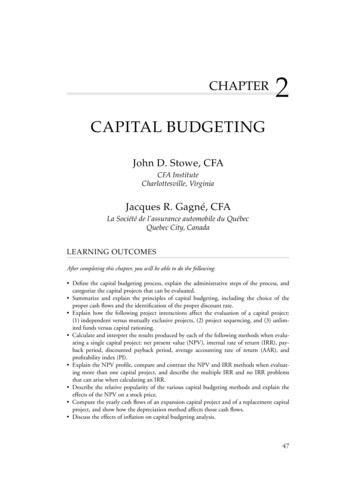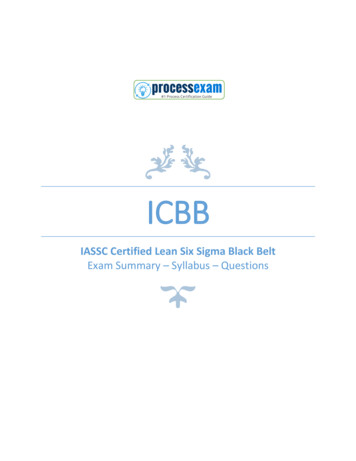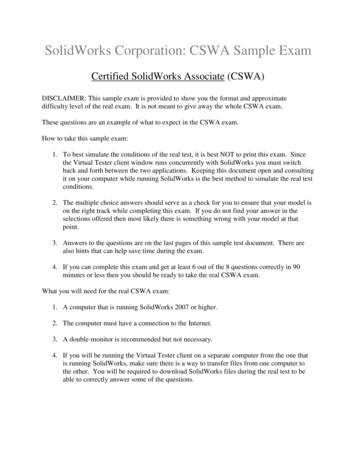
Transcription
CHAPTER2CAPITAL BUDGETINGJohn D. Stowe, CFACFA InstituteCharlottesville, VirginiaJacques R. Gagné, CFALa Société de l’assurance automobile du QuébecQuebec City, CanadaLEARNING OUTCOMESAfter completing this chapter, you will be able to do the following: Define the capital budgeting process, explain the administrative steps of the process, andcategorize the capital projects that can be evaluated. Summarize and explain the principles of capital budgeting, including the choice of theproper cash flows and the identification of the proper discount rate. Explain how the following project interactions affect the evaluation of a capital project:(1) independent versus mutually exclusive projects, (2) project sequencing, and (3) unlimited funds versus capital rationing. Calculate and interpret the results produced by each of the following methods when evaluating a single capital project: net present value (NPV), internal rate of return (IRR), payback period, discounted payback period, average accounting rate of return (AAR), andprofitability index (PI). Explain the NPV profile, compare and contrast the NPV and IRR methods when evaluating more than one capital project, and describe the multiple IRR and no IRR problemsthat can arise when calculating an IRR. Describe the relative popularity of the various capital budgeting methods and explain theeffects of the NPV on a stock price. Compute the yearly cash flows of an expansion capital project and of a replacement capitalproject, and show how the depreciation method affects those cash flows. Discuss the effects of inflation on capital budgeting analysis.47c02.indd 473/18/08 10:33:06 AM
48Corporate Finance Select the optimal capital project in situations of (1) mutually exclusive projects with unequallives, using either the least common multiple of lives approach or the equivalent annualannuity approach, and (2) capital rationing. Explain how sensitivity analysis, scenario analysis, and Monte Carlo simulation can be usedto estimate the standalone risk of a capital project. Discuss the procedure for determining the discount rate to be used in valuing a capitalproject and illustrate the procedure based on the CAPM. Discuss the types of real options and evaluate the profitability of investments with realoptions. Describe several capital budgeting pitfalls. Calculate and interpret accounting income and economic income in the context of capitalbudgeting. Describe and contrast the following valuation models of a capital project: economic profit(EP), residual income, and claims valuation.1. INTRODUCTIONCapital budgeting is the process that companies use for decision making on capital projects—projects with a life of a year or more. This is a fundamental area of knowledge for financialanalysts for many reasons. First, capital budgeting is very important for corporations. Capital projects, which make upthe long-term asset portion of the balance sheet, can be so large that sound capital budgeting decisions ultimately decide the future of many corporations. Capital decisions cannotbe reversed at a low cost, so mistakes are very costly. Indeed, the real capital investments ofa company describe a company better than its working capital or capital structures, whichare intangible and tend to be similar for many corporations. Second, the principles of capital budgeting have been adapted for many other corporatedecisions, such as investments in working capital, leasing, mergers and acquisitions, andbond refunding. Third, the valuation principles used in capital budgeting are similar to the valuation principles used in security analysis and portfolio management. Many of the methods used bysecurity analysts and portfolio managers are based on capital budgeting methods. Conversely, there have been innovations in security analysis and portfolio management thathave also been adapted to capital budgeting. Finally, although analysts have a vantage point outside the company, their interest in valuation coincides with the capital budgeting focus of maximizing shareholder value. Becausecapital budgeting information is not ordinarily available outside the company, the analystmay attempt to estimate the process, within reason, at least for companies that are not toocomplex. Further, analysts may be able to appraise the quality of the company’s capitalbudgeting process, for example, on the basis of whether the company has an accountingfocus or an economic focus.This chapter is organized as follows: Section 2 presents the steps in a typical capitalbudgeting process. After introducing the basic principles of capital budgeting in Section 3,in Section 4 we discuss the criteria by which a decision to invest in a project may be made.c02.indd 483/18/08 10:33:07 AM
Chapter 2Capital Budgeting49Section 5 presents a crucial element of the capital budgeting process: organizing the cashflow information that is the raw material of the analysis. Section 6 looks further at cash flowanalysis. Section 7 demonstrates methods to extend the basic investment criteria to addresseconomic alternatives and risk. Finally, Section 8 compares other income measures and valuation models that analysts use to the basic capital budgeting model.2. THE CAPITAL BUDGETING PROCESSThe specific capital budgeting procedures that managers use depend on their level in theorganization, the size and complexity of the project being evaluated, and the size of the organization. The typical steps in the capital budgeting process are as follows: Step one, generating ideas: Investment ideas can come from anywhere, from the top or thebottom of the organization, from any department or functional area, or from outsidethe company. Generating good investment ideas to consider is the most important stepin the process. Step two, analyzing individual proposals: This step involves gathering the information toforecast cash flows for each project and then evaluating the project’s profitability. Step three, planning the capital budget: The company must organize the profitable proposalsinto a coordinated whole that fits within the company’s overall strategies, and it also mustconsider the projects’ timing. Some projects that look good when considered in isolationmay be undesirable strategically. Because of financial and real resource issues, schedulingand prioritizing projects are important. Step four, monitoring and postauditing: In a postaudit, actual results are compared toplanned or predicted results, and any differences must be explained. For example, howdo the revenues, expenses, and cash flows realized from an investment compare to thepredictions? Postauditing capital projects is important for several reasons. First, it helpsmonitor the forecasts and analysis that underlie the capital budgeting process. Systematicerrors, such as overly optimistic forecasts, become apparent. Second, it helps improvebusiness operations. If sales or costs are out of line, it will focus attention on bringingperformance closer to expectations if at all possible. Finally, monitoring and postauditingrecent capital investments will produce concrete ideas for future investments. Managerscan decide to invest more heavily in profitable areas and scale down or cancel investmentsin areas that are disappointing.Planning for capital investments can be very complex, often involving many personsinside and outside the company. Information about marketing, science, engineering, regulation, taxation, finance, production, and behavioral issues must be systematically gatheredand evaluated. The authority to make capital decisions depends on the size and complexity of the project. Lower-level managers may have discretion to make decisions that involveless than a given amount of money or that do not exceed a given capital budget. Larger andmore complex decisions are reserved for top management, and some are so significant thatthe company’s board of directors ultimately has the decision-making authority.Like everything else, capital budgeting is a cost–benefit exercise. At the margin, thebenefits from the improved decision making should exceed the costs of the capital budgetingefforts.c02.indd 493/18/08 10:33:07 AM
50Corporate FinanceCompanies often put capital budgeting projects into rough categories for analysis. Onesuch classification is as follows:1. Replacement projects: These are among the easier capital budgeting decisions. If a pieceof equipment breaks down or wears out, whether to replace it may not require carefulanalysis. If the expenditure is modest and if not investing has significant implications forproduction, operations, or sales, it would be a waste of resources to overanalyze the decision. Just make the replacement. Other replacement decisions involve replacing existingequipment with newer, more efficient equipment or perhaps choosing one type of equipment over another. These replacement decisions are often amenable to very detailedanalysis, and you might have a lot of confidence in the final decision.2. Expansion projects: Instead of merely maintaining a company’s existing business activities, expansion projects increase the size of the business. These expansion decisions mayinvolve more uncertainties than replacement decisions, and they should be more carefully considered.3. New products and services: These investments expose the company to even more uncertainties than expansion projects. These decisions are more complex and will involvemore people in the decision-making process.4. Regulatory, safety, and environmental projects: These projects are frequently required bya governmental agency, an insurance company, or some other external party. They maygenerate no revenue and might not be undertaken by a company maximizing its ownprivate interests. Often, the company will accept the required investment and continueto operate. Occasionally, however, the cost of the regulatory, safety, or environmentalproject is sufficiently high that the company would do better to cease operating altogether or to shut down any part of the business that is related to the project.5. Other: The preceding projects are all susceptible to capital budgeting analysis, and theycan be accepted or rejected using the net present value (NPV) or some other criterion.Some projects escape such analysis. These are either pet projects of someone in the company (such as the CEO buying a new aircraft) or so risky that they are difficult to analyze by the usual methods (such as some research and development decisions).3. BASIC PRINCIPLES OF CAPITAL BUDGETINGCapital budgeting has a rich history and sometimes employs some sophisticated procedures.Fortunately, capital budgeting relies on just a few basic principles and typically uses the following assumptions:1. Decisions are based on cash flows: The decisions are not based on accounting concepts,such as net income. Furthermore, intangible costs and benefits are often ignored because,if they are real, they should result in cash flows at some other time.2. Timing of cash flows is crucial: Analysts make an extraordinary effort to detail preciselywhen cash flows occur.3. Cash flows are based on opportunity costs: What are the incremental cash flows that occurwith an investment, compared to what they would have been without the investment?4. Cash flows are analyzed on an after-tax basis: Taxes must be fully reflected in all capitalbudgeting decisions.c02.indd 503/18/08 10:33:08 AM
Chapter 2Capital Budgeting515. Financing costs are ignored: This may seem unrealistic, but it is not. Most of the time,analysts want to know the after-tax operating cash flows that result from a capital investment. Then these after-tax cash flows and the investment outlays are discounted at therequired rate of return to find the net present value (NPV). Financing costs are reflectedin the required rate of return. If we included financing costs in the cash flows and in thediscount rate, we would be double-counting the financing costs. So. even though a project may be financed with some combination of debt and equity, we ignore these costs,focusing on the operating cash flows and capturing the costs of debt (and other capital)in the discount rate.Capital budgeting cash flows are not accounting net income. Accounting net incomeis reduced by noncash charges such as accounting depreciation. Furthermore, to reflect thecost of debt financing, interest expenses are also subtracted from accounting net income. (Nosubtraction is made for the cost of equity financing in arriving at accounting net income.)Accounting net income also differs from economic income, which is the cash inflow plusthe change in the market value of the company. Economic income does not subtract the costof debt financing, and it is based on the changes in the market value of the company, noton changes in its book value (accounting depreciation). We will further consider cash flows,accounting income, economic income, and other income measures at the end of this chapter.In assumption 5, we referred to the rate used in discounting the cash flows as the requiredrate of return, which is the discount rate that investors should require given the riskiness ofthe project. This discount rate is frequently called the opportunity cost of funds or the costof capital. If the company can invest elsewhere and earn a return of r, or if the company canrepay its sources of capital and save a cost of r, then r is the company’s opportunity cost offunds. If the company cannot earn more than its opportunity cost of funds on an investment,it should not undertake that investment. Unless an investment earns more than the cost offunds from its suppliers of capital, the investment should not be undertaken. The cost-ofcapital concept is discussed more extensively elsewhere. Regardless of what it is called, an economically sound discount rate is essential for making capital budgeting decisions.Although the principles of capital budgeting are simple, they are easily confused inpractice, leading to unfortunate decisions. Some important capital budgeting concepts thatmanagers find very useful are as follows: A sunk cost is one that has already been incurred. You cannot change a sunk cost. Today’sdecisions, on the other hand, should be based on current and future cash flows and shouldnot be affected by prior, or sunk, costs. An opportunity cost is what a resource is worth in its next best use. For example, if a company uses idle property, what should it record as the investment outlay: the purchase priceseveral years ago, the current market value, or nothing? If you replace an old machine witha new one, what is the opportunity cost? If you invest 10 million, what is the opportunitycost? The answers to these three questions are, respectively: the current market value, thecash flows that the old machine would generate, and 10 million (which you could investelsewhere). An incremental cash flow is the cash flow that is realized because of a decision: the cashflow with a decision minus the cash flow without that decision. If opportunity costs arecorrectly assessed, the incremental cash flows provide a sound basis for capital budgeting. An externality is the effect of an investment on other things besides the investment itself.Frequently, an investment affects the cash flows of other parts of the company, and thesec02.indd 513/18/08 10:33:08 AM
52Corporate Financeexternalities can be positive or negative. If possible, these should be part of the investmentdecision. Sometimes externalities occur outside the company. An investment might benefit(or harm) other companies or society at large; yet the company is not compensated forthese benefits (or charged for the costs). Cannibalization is one externality. Cannibalization occurs when an investment takes customers and sales away from another part of thecompany. A conventional cash flow pattern is one with an initial outflow followed by a series ofinflows. In a nonconventional cash flow pattern, the initial outflow is not followedby inflows only, but the cash flows can flip from positive to negative again (or even changesigns several times). An investment that involved outlays (negative cash flows) for the firstcouple of years that were then followed by positive cash flows would be considered to havea conventional pattern. If cash flows change signs once, the pattern is conventional. If cashflows change signs two or more times, the pattern is nonconventional.Several types of project interactions make the incremental cash flow analysis challenging.The following are some of these interactions: Independent projects versus mutually exclusive projects: Independent projects areprojects whose cash flows are independent of each other. Mutually exclusive projects compete directly with each other. For example, if Projects A and B are mutually exclusive, youcan choose A or B, but you cannot choose both. Sometimes there are several mutually exclusive projects, and you can choose only one from the group. Project sequencing: Many projects are sequenced through time so that investing in a projectcreates the option to invest in future projects. For example, you might invest in a project todayand then in one year invest in a second project if the financial results of the first project or neweconomic conditions are favorable. If the results of the first project or new economic conditions are not favorable, you do not invest in the second project. Unlimited funds versus capital rationing: An unlimited funds environment assumes thatthe company can raise the funds it wants for all profitable projects simply by paying therequired rate of return. Capital rationing exists when the company has a fixed amount offunds to invest. If the company has more profitable projects than it has funds for, it must allocate the funds to achieve the maximum shareholder value subject to the funding constraints.4. INVESTMENT DECISION CRITERIAAnalysts use several important criteria to evaluate capital investments. The two most comprehensive measures of whether a project is profitable or unprofitable are the net present value(NPV) and internal rate of return (IRR). In addition to these, we present four other criteriathat are frequently used: the payback period, discounted payback period, average accounting rate of return (AAR), and profitability index (PI). An analyst must fully understand theeconomic logic behind each of these investment decision criteria, as well as its strengths andlimitations in practice.4.1. Net Present ValueFor a project with one investment outlay, made initially, the net present value (NPV) is thepresent value of the future after-tax cash flows minus the investment outlay, orc02.indd 523/18/08 10:33:08 AM
Chapter 253Capital BudgetingnCFt Outlaytt 1 (1 r )NPV (2-1)whereCFt after-tax cash flow at time tr required rate of return for the investmentOutlay investment cash flow at time 0To illustrate the net present value criterion, we will take a look at a simple example.Assume that Gerhardt Corporation is considering an investment of 50 million in a capitalproject that will return after-tax cash flows of 16 million per year for the next four yearsplus another 20 million in year 5. The required rate of return is 10 percent.For the Gerhardt example, the NPV would be1616161620 50 12341.101.101.101.101.105 14.545 13.223 12.021 10.928 12.418 50NPV 63.136 50 13.136 million.1The investment has a total value, or present value of future cash flows, of 63.136 million.Since this investment can be acquired at a cost of 50 million, the investing company is giving up 50 million of its wealth in exchange for an investment worth 63.136 million. Theinvestor’s wealth increases by a net of 13.136 million.Because the NPV is the amount by which the investor’s wealth increases as a result of theinvestment, the decision rule for the NPV is as follows:Invest ifNPV 0Do not invest if NPV 0Positive NPV investments are wealth increasing, and negative NPV investments are wealthdecreasing.Many investments have cash flow patterns in which outflows may occur not only at time 0,but also at future dates. It is useful to consider the NPV to be the present value of all cash flows:NPV CF0 CF1CF2CFn 12(1 r )(1 r )(1 r )norNPV nCFt (1 r )t 0t(2-2)In Equation 2-2, the investment outlay, CF0, is simply a negative cash flow. Future cash flowscan also be negative.1Occasionally, you will notice some rounding errors in our examples. In this case, the present values ofthe cash flows, as rounded, add up to 63.135. Without rounding, they add up to 63.13627, or 63.136.We will usually report the more accurate result, the one that you would get from your calculator orcomputer without rounding intermediate results.c02.indd 533/18/08 10:33:09 AM
54Corporate Finance4.2. Internal Rate of ReturnThe internal rate of return (IRR) is one of the most frequently used concepts in capitalbudgeting and in security analysis. The IRR definition is one that all analysts know byheart. For a project with one investment outlay, made initially, the IRR is the discount ratethat makes the present value of the future after-tax cash flows equal that investment outlay.Written out in equation form, the IRR solves this equation:nCFt (1 IRR )tt 1 Outlaywhere IRR is the internal rate of return. The left-hand side of this equation is the presentvalue of the project’s future cash flows, which, discounted at the IRR, equals the investmentoutlay. This equation will also be seen rearranged asnCFt (1 IRR )t 1t Outlay 0(2-3)In this form, Equation 2-3 looks like the NPV equation, Equation 2-1, except that the discount rate is the IRR instead of r (the required rate of return). Discounted at the IRR, theNPV is equal to 0.In the Gerhardt Corporation example, we want to find a discount rate that makes thetotal present value of all cash flows, the NPV, equal 0. In equation form, the IRR is the discount rate that solves this equation: 50 1616161620 01234(1 IRR )(1 IRR)(1 IRR)(1 IRR)(1 IRR)5Algebraically, this equation would be very difficult to solve. We normally resort to trialand error, systematically choosing various discount rates until we find one, the IRR, thatsatisfies the equation. We previously discounted these cash flows at 10 percent and foundthe NPV to be 13.136 million. Since the NPV is positive, the IRR is probably greaterthan 10 percent. If we use 20 percent as the discount rate, the NPV is – 0.543 million; so20 percent is a little high. One might try several other discount rates until the NPV is equalto 0; this approach is illustrated in Exhibit 2-1.EXHIBIT 2-1 Trial-and-Error Process for Finding IRRDiscount Ratec02.indd 54NPV10%13.13620% 08 10:33:10 AM
Chapter 255Capital BudgetingThe IRR is 19.52 percent. Financial calculators and spreadsheet software have routinesthat calculate the IRR for us, so that we do not have to go through this trial-and-errorprocedure ourselves. The IRR, computed more precisely, is 19.5197 percent.The decision rule for the IRR is to invest if the IRR exceeds the required rate of returnfor a project:Invest ifIRR rDo not invest if IRR rIn the Gerhardt example, since the IRR of 19.52 percent exceeds the project’s requiredrate of return of 10 percent, Gerhardt should invest.Many investments have cash flow patterns in which the outlays occur at time 0 and atfuture dates. Thus it is common to define the IRR as the discount rate that makes the presentvalues of all cash flows sum to 0:nCFt (1 IRR)tt 0 0(2-4)Equation 2-4 is a more general version of Equation 2-3.4.3. Payback PeriodThe payback period is the number of years required to recover the original investment ina project. The payback is based on cash flows. For example, if you invest 10 thousandin a project, how long will it be until you recover the full original investment? Exhibit 2-2illustrates the calculation of the payback period by following an investment’s cash flows andcumulative cash flows.In the first year, the company recovers 2,500 of the original investment, with 7,500still unrecovered. You can see that the company recoups its original investment betweenyear 3 and year 4. After three years, 2,000 is still unrecovered. Since the year 4 cash flow is 3,000, it would take two-thirds of the year 4 cash flow to bring the cumulative cash flow to 0.So the payback period is three years plus two-thirds of the year 4 cash flow, or 3.67 years.The drawbacks of the payback period are transparent. Since the cash flows are not discounted at the project’s required rate of return, the payback period ignores the time value ofmoney and the risk of the project. Additionally, the payback period ignores cash flows afterthe payback period is reached. In Exhibit 2-2, for example, the year 5 cash flow is completelyignored in the payback computation!Example 2-1 on page 56 is designed to illustrate some of the implications of these drawbacks of the payback period.The payback period has many drawbacks—it is a measure of payback and not a measureof profitability. By itself, the payback period would be a dangerous criterion for evaluatingcapital projects. Its simplicity, however, is an advantage. The payback period is very easy toEXHIBIT 2-2 Payback Period Example ( )Yearc02.indd 55012345Cash flow 10,0002,5002,5003,0003,0003,000Cumulative cash flow 10,000 7,500 5,000 2,0001,0004,0003/18/08 10:33:10 AM
56Corporate FinanceEXAMPLE 2-1Drawbacks of the Payback PeriodThe cash flows, payback periods, and NPVs for Projects A through F are given inExhibit 2-3. For all of the projects, the required rate of return is 10 percent.EXHIBIT 2-3 Examples of Drawbacks of the Payback PeriodCash FlowsYearProject AProject BProject CProject DProject EProject F0 1,000 1,000 1,000 1,000 1,000 0040010,000440010040055005004001.04.04.02.02.52.0 90.9165.26140.60243.43516.317,380.92Payback periodNPVComment on why the payback period provides misleading information about thefollowing:1.2.3.4.Project A.Project B versus Project C.Project D versus Project E.Project D versus Project F.Solutions1. Project A does indeed pay itself back in one year. However, this result is misleading because the investment is unprofitable, with a negative NPV.2. Although Projects B and C have the same payback period and the same cash flowafter the payback period, the payback period does not detect the fact that ProjectC’s cash flows within the payback period occur earlier and result in a higher NPV.3. Projects D and E illustrate a common situation. The project with the shorterpayback period is the less profitable project. Project E has a longer payback andhigher NPV.4. Projects D and F illustrate an important flaw of the payback period: The payback period ignores cash flows after the payback period is reached. In this case,Project F has a much larger cash flow in Year 3, but the payback period does notrecognize its value.c02.indd 563/18/08 10:33:11 AM
Chapter 257Capital Budgetingcalculate and to explain. The payback period may also be used as an indicator of projectliquidity. A project with a two-year payback may be more liquid than another project with alonger payback.Because it is not economically sound, the payback period has no decision rule like thatof the NPV or IRR. If the payback period is being used (perhaps as a measure of liquidity),analysts should also use an NPV or IRR to ensure that their decisions also reflect the profitability of the projects being considered.4.4. Discounted Payback PeriodThe discounted payback period is the number of years it takes for the cumulative discountedcash flows from a project to equal the original investment. The discounted payback periodpartially addresses the weaknesses of the payback period. Exhibit 2-4 gives an example of calculating the payback period and discounted payback period. The example assumes a discountrate of 10 percent.EXHIBIT 2-4 Payback Period and Discounted Payback PeriodYear012345Cash flow umulative CF 5,000 3,500.00 2,000.00 500.001,000.002,500.00Discounted CF ivediscounted CF 5,000 3,636.36 2,396.69 1,269.72 245.20686.18The payback period is three years plus 500/1,500 1/3 of the fourth year’s cash flow,or 3.33 years. The discounted payback period is between four and five years. The discountedpayback period is four years plus 245.20/931.38 0.26 of the fifth year’s discounted cashflow, or 4.26 years.The discounted payback period relies on discounted cash flows, much as the NPV criterion does. If a project has a negative NPV, it will usually not have a discounted paybackperiod since it never recovers the initial investment.The discounted payback does account for the time value of money and risk within thediscounted payback period, but it ignores cash flows after the discounted payback period isreached. This drawback has two consequences. First, the discounted payback period is nota good measure of profitability (like the NPV or IRR) because it ignores these cash flows.A second idiosyncrasy of the discounted payback period comes from the possibility of negative cash flows after the discounted payback period is reached. It is possible for a project tohave a negative NPV but to have a positive cumulative discounted cash flow in the middle ofits life and thus a reasonable discounted payback period. The NPV and IRR, which considerall of a project’s cash flows, do not suffer from this problem.4.5. Average Accounting Rate of ReturnThe average accounting rate of return (AAR) can be defined asAverage net incomeAverage book valueTo understand this measure of return, we will use a numerical example.AAR c02.indd 573/18/08 10:33:11 AM
58Corporate FinanceEXHIBIT 2-5 Net Income for Calculating an Average Accoun
Compute the yearly cash fl ows of an expansion capital project and of a replacement capital project, and show how the depreciation method affects those cash fl ows. Discuss the effects of infl ation on capital budgeting analysis. cc02.indd 4702.indd 47 33/18/08 10:33:06 AM/18/08 10:33:06 AM










